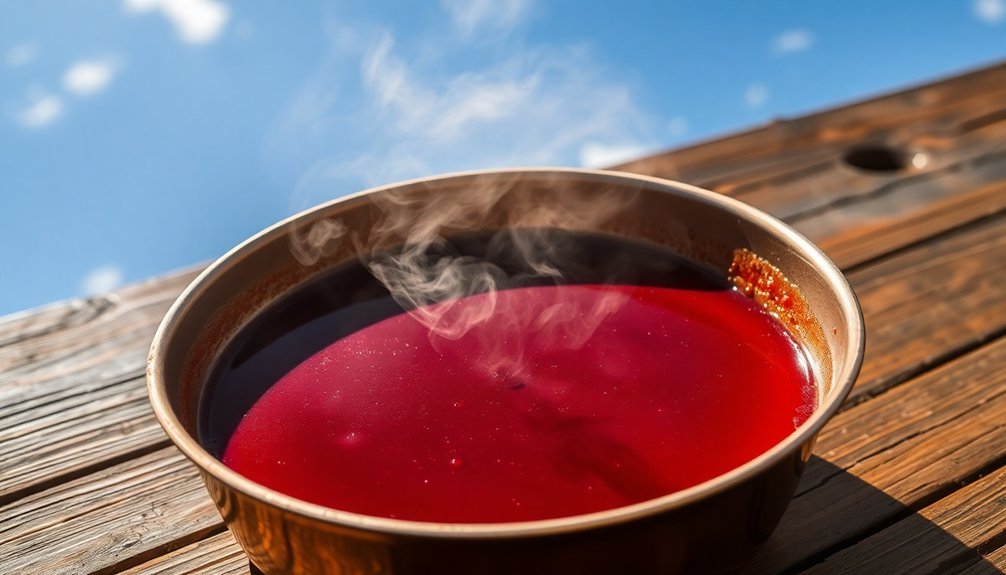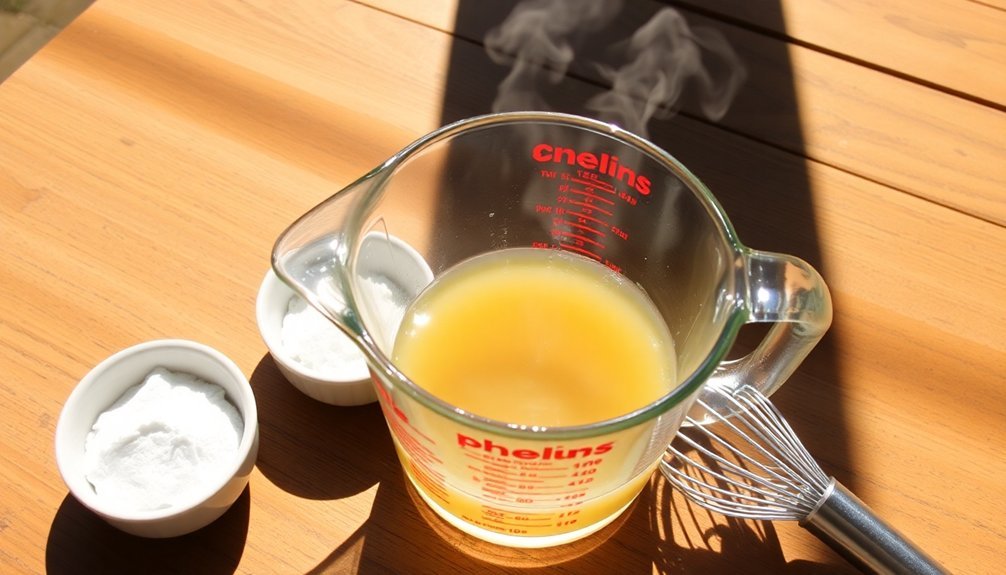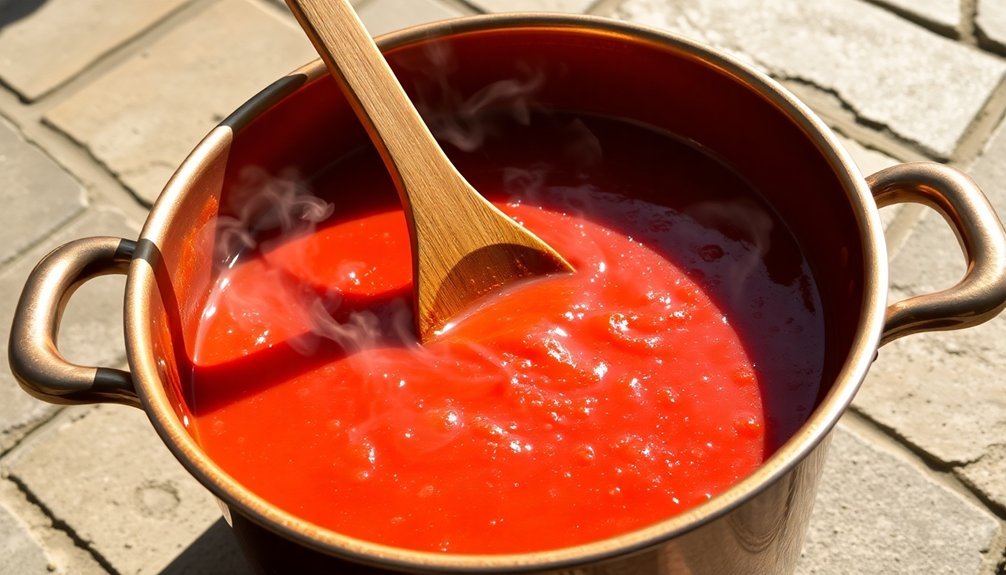You can thicken sauces naturally using five sun-powered methods. Try slow solar reduction by placing your sauce in a wide, shallow container during peak sunlight hours. Make a roux by combining equal parts flour and fat in a dark pan under direct sunlight, stirring constantly. Create a cornstarch slurry and let the sun's heat activate its thickening properties. Emulsify sun-warmed butter gradually into reduced liquids for silky sauces. Blend cooked starchy vegetables like potatoes or squash for a natural thickening puree. These eco-friendly techniques offer just the beginning of your sustainable cooking journey.
Slow Solar Liquid Reduction

Liquid reduction in the sun operates similarly to pool solar covers, creating an invisible barrier that traps heat and moisture.
You'll notice that when you place your sauce in direct sunlight, it forms a thin molecular layer on top that helps control evaporation while concentrating flavors underneath.
To maximize this natural thickening process, you'll want to choose peak sunlight hours, typically between June and August in the Northern Hemisphere.
The higher the sun's radiation and surrounding air temperature, the more efficient your reduction will be.
Just like pools that lose 70% of energy through evaporation, sauces can rapidly lose moisture and heat without proper coverage.
Place your sauce in a wide, shallow container to increase surface area exposure.
While wind typically increases evaporation rates, you'll want to protect your sauce from strong breezes to maintain that essential surface tension layer and guarantee even reduction.
Roux Under Direct Sunlight
While traditional roux-making relies on stovetop heat, you can harness solar energy to create this essential sauce thickener. You'll need equal parts flour and fat (butter, chicken fat, or margarine) and a sun-exposed cooking surface.
When working with solar heat, you'll want to start with a white or blonde roux since they require less cooking time. Mix your flour and fat in a dark, heat-conducting pan, and place it in direct sunlight. Stir constantly to prevent lumps and guarantee even cooking. You'll know it's ready when the raw flour smell disappears. This method works best for white roux, which only needs 2-3 minutes of cooking.
Once your solar-cooked roux is done, you can either use it immediately or store it for later. Remember to add cold liquid to your hot roux gradually while whisking to achieve a smooth, lump-free sauce.
Solar Heat Cornstarch Method

Just as roux can harness solar energy, cornstarch offers an efficient alternative for thickening sauces in sunny conditions. You'll need to create a slurry by mixing equal parts cornstarch and cold liquid, using 1 tablespoon per cup of sauce. While your sauce heats in the sun, verify it's hot but not boiling before adding your well-mixed slurry. The thickening process creates a glossy, shiny finish that's particularly appealing in clear sauces.
| Time | Temperature | Action |
|---|---|---|
| 0 min | Cold | Mix slurry |
| 5 min | Warm | Heat sauce |
| 10 min | Hot | Add slurry |
| 11 min | Very hot | Stir constantly |
| 12 min | Hot | Let set |
Keep stirring until the sauce turns from cloudy to clear. You'll notice it thicken within a minute of reaching peak heat. Don't overcook, as this can break down the starch and thin your sauce.
Sun-Warmed Butter Emulsification
Through careful temperature control, sun-warmed butter emulsification creates stable, velvety sauces without traditional stovetop heating.
You'll want to start by reducing your base liquid in advance, then let the sun warm your butter to just below 140°F to prevent breaking. For best results, whisk cold butter pieces into your reduced liquid gradually while maintaining a consistent temperature in the sunlight.
To guarantee stability, you can add a small amount of polysorbate 80, which handles heat better than xanthan gum and won't separate at higher temperatures. Vigorous whisking is essential for proper emulsification of beurre blanc and beurre monte preparations.
If you're making a beurre blanc or beurre monte, strain out any solids first, then create a slurry with your emulsifier before incorporating it.
Remember that timing is essential – you'll need to serve butter-based sauces promptly to maintain their silky texture.
Natural Light Puree Thickening

Moving beyond butter-based techniques, natural vegetable purees offer a sun-powered alternative for thickening sauces.
You'll find starchy vegetables like potatoes, winter squash, and celeriac work best, especially after roasting them in natural daylight.
To achieve excellent results, you'll want to fully cook your chosen vegetables before pureeing them in a food processor.
You can blend cauliflower, beans, or lentils too, though they'll add their distinct flavors.
When you're ready, stir the puree into your sauce gradually until you reach your desired thickness.
For the best integration, try mixing your puree with a small portion of the sauce first to prevent lumps.
Don't forget to simmer the mixture afterward – this guarantees your flavors meld perfectly while achieving that ideal, smooth consistency.
Frequently Asked Questions
Can Cloudy Weather Affect the Sauce Thickening Process Using Solar Methods?
You won't get reliable thickening results in cloudy weather since there's inconsistent solar heat. It's better to use conventional stovetop methods, where you'll have precise temperature control for proper sauce thickening.
What Containers Work Best for Sun-Based Sauce Thickening Techniques?
You'll want shallow, dark-colored containers with wide mouths and thick bottoms. Glass or metal pans work best, as they'll absorb heat effectively. Make sure they're non-reactive and have a large surface area.
How Do You Prevent Bacterial Growth During Solar Sauce Thickening?
You'll need to acidify your sauce with lemon juice or vinegar, use clean containers, cover with breathable mesh, and monitor temperature closely. Don't thicken during humid days to control water activity.
Does UV Radiation Affect the Nutritional Content of Sun-Thickened Sauces?
Yes, you'll lose nutrients when thickening sauces in UV light. It'll break down vitamins (especially C and B), change amino acids, and oxidize fats. Consider using shade or shorter exposure times to preserve nutrients.
What's the Maximum Safe Time to Leave Sauces Under Direct Sunlight?
You shouldn't leave sauces under direct sunlight at all. If you must, limit exposure to 15-20 minutes maximum, as sunlight can cause rapid bacterial growth and quality deterioration beyond this timeframe.
In Summary
You'll find these solar-powered thickening methods both eco-friendly and effective for creating rich, velvety sauces. Whether you're reducing liquids in the sun, making a sun-warmed roux, or using cornstarch under natural light, you've now got sustainable options for achieving the perfect consistency. Don't hesitate to experiment with these techniques – they'll help you create professional-quality sauces while harnessing the sun's natural energy.





Leave a Reply